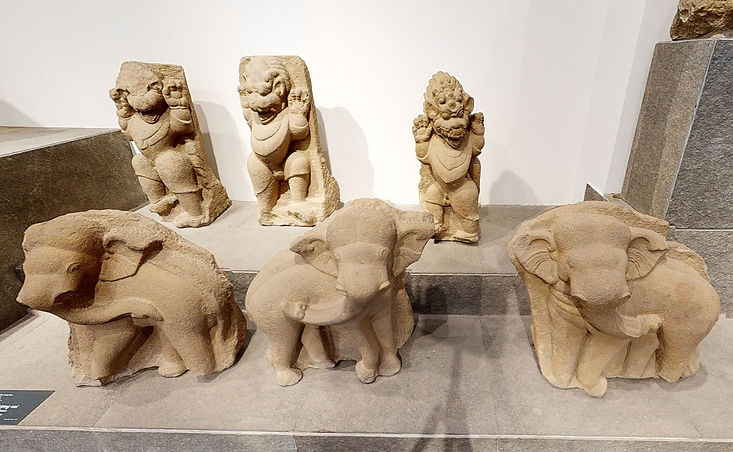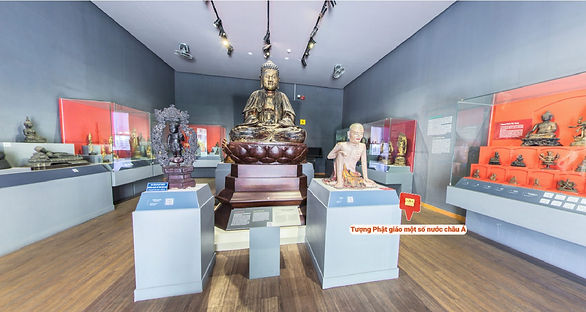Ho Chi Minh City
Museum of Vietnamese History
Modern Vietnamese Culture and Society | Final Project
Suggestions for re-curating the Champa exhibition room
1. The unjustifiable position of the Dong Duong Buddha bronzes collection:
As long as explanations of the central position of Buddha are provided, we think that the combined displacement of the Dong Duong Buddha bronzes and the Go Sanh pottery collection should be repaired. It is necessary to split Buddha and other ceramics, and stoneware into two different areas to elevate the significance and solemnity of the Buddha artifacts collection in this Champa room.

2. The unorganized order of the gods and goddesses statues: Following the criticism that the order of the same type of god and goddess artifacts is unorganized, we argue that they should be positioned in different places with special implications, or at least together in a homogenous batch.


3. Inconsistency in theme color selections to provoke solemnity and religious context:
While the curators of the Champa culture room may have claimed that the solemnity of these objects would be enhanced by the use of the colors black, white, and grey, there is evidence to the contrary. In reality, the Asian Buddhism gallery in this museum is incorporating a vigorous concept while still evoking a serious and sacred ambiance. This distinction in theme selections suggests that the curators of the Champa culture room expected that the solemnity and religious context of the collection would not be impacted by the colors they picked. Therefore, we contend that more powerful, striking, and vivid color palettes can and should be used in the design of the Champa culture exhibition.
4. The shortage of significance statues in the Champa culture:
In fact, the three most influential Hindu gods in Champa culture are Brahma (“The Creator”), Vishnu (“The Pervader”), and Shiva (“The Destroyer”). However, there are not any Brahma statues in this exhibition room. That could be explained by the fact that the collection at the museum does not own any due to the limited works excavated. This shortage could, to some extent, affect the overall storytelling of this room since the strong influence of Hinduism in Champa culture could not be expressed at its best. An alternative method to improve that is to make replicas of the Brahma statues that have been discovered yet are currently being displayed at other institutions across the world. One example of a replica statue is this enormous Buddha in the Ly dynasty room. The lack of an authentic version of the Buddha could be explained for two reasons, the first one is that it is already lost or the museum does not owe it. However, the fact that the Ly-Tran dynasty (1009 – 1400 A.D.) was known as the golden age of Vietnamese Buddhism makes it compulsory for the museum curators to include the Buddha in the Ly dynasty exhibition room.

5. Inefficient lighting:
Natural light must be reduced for its ineffectiveness in helping to explain the collection, and artificial light sources must be properly adjusted to precisely spotlight specific items. Although the curators tried to fix the issue by installing white curtains for the windows, the thin curtains could only block a few of the direct sunlight, not to mention some windows that are not covered by any curtains or glass. If any windows in contemporary museum are left uncovered, those are only windows high above near the ceiling to make the room well-ventilated. We claim that only with thicker, darker-colored curtains and more intense, concentrated studio lights installed will the objects be illuminated on view.


6. Minimalist signage and interpretation: We believe that the signage should be re-designed with more information to avoid decontextualization. It is feasible for the museum curator to do so as what they have excellently carried out with the Statue of the Goddess Devi in this room. For the Devi Statue, both the historical and excavating context is clearly provided. Right from the very first lines, readers can quickly grasp the information that the Statue was found in Quang Nam in 1911, and journeyed through another institution before officially arriving at the HCMC Museum of History. It is also deeply analyzed in terms of the history of the original model Devi that the statue was based on and the Champa ethnographic idea of aesthetics.

QR code of the statue of Goddess Devi, which has been recognized as a National Treasure in 2012:

7. Future prospects and opportunities for technology application:
Aside from QR codes, the museum can use additional resources such as the 3D museum, touchscreens, AV projectors for filming and screening, and even virtual reality (VR) devices to fully utilize technology applications in aiding visitors' understanding of its collection. We have to put emphasis on "3D museum" as it is not only a creative approach for museum tours but also a convenient feature that is feasible immediately. In the 3D museum from the company StarGlobal3D, which we initially showed at the beginning of our presentation, an interesting 360-viewpoint technology has been specially designed for the Statue of Siva (next to the Nandi ox). In fact, many advanced museums around the world have been using this 360-viewpoint technology for a long time, and it is a good sign to see that a Vietnamese museum like the HCMC Museum of History and tech firms are collaborating to adopt this into both their physical and virtual museum tours. More statues and sculptures should be reproduced in 360° viewpoint technology, such as Siva's, to make this 3D approach an inseparable part of museum tours.

8. The incorporation of artifacts into a temple/architectural context:
With the Devi goddess that is a national treasure of Vietnam, we sugesst that they should be displayed together with architectural models to avoid the problem of de-contextualization. Other museums has improved this situation by using backdrops with images of temple-towers (Binh Dinh provincial museum) or put the object inside an architectural model (National Palace Museum – Southern Branch with the display of the linga-kosa inside the model of a temple). By observing objects placed in a temple-resembling context, visitors may better visualize where the objects were originally located rather than seeing them stand individually on plinths in a clean, white-walled building.

The current display of Devi Goddess in HCMC Museum of Vietnamese History
.jpg)
National Palace Museum – Southern Branch with the display of the linga-kosa inside the model of a temple
A sculpture with image of temple-towers as a background in Binh Dinh provincial museum

For further efforts to recurate this room in particular and other indigenous cultures of Vietnam, curators should consider include the people of that specifc culture, which is the source community, in their projects to create an “inclusive museum”. This idea is certainly not new in Vietnam. In the Vietnam Museum of Ethnology, the dwellers belonging to ethnic group in Central Highlands, Northwest Region, ... were invited to build their own traditional houses based on their experience. Since they are the owners of this cultural heritage, we, as the curators, thus must listen to and respect their voices.

"The Rong House" of The Bahnar in Vietnam Museum of Ethnology